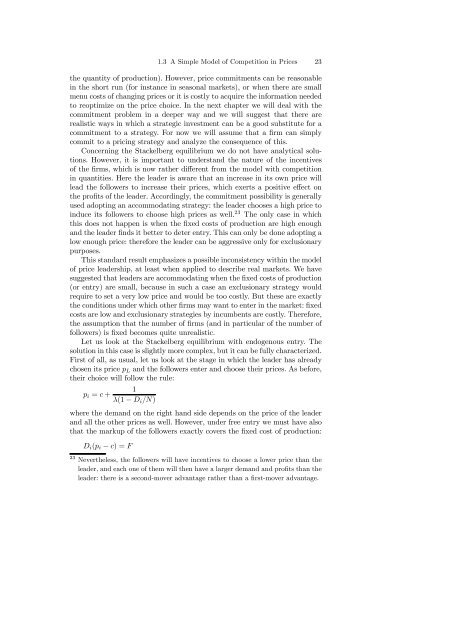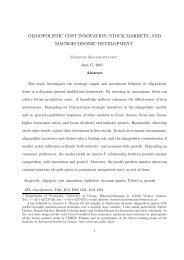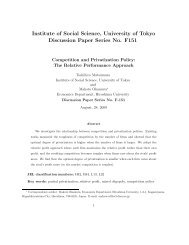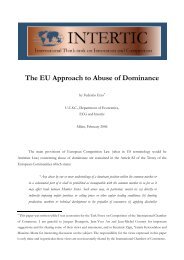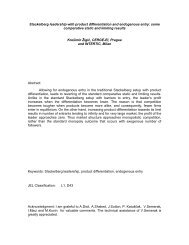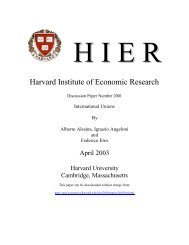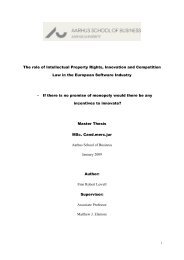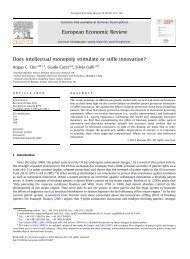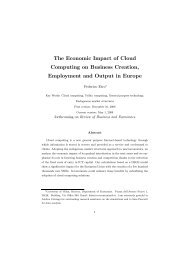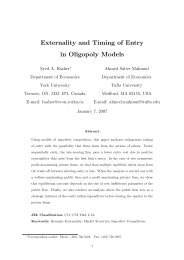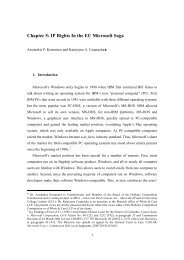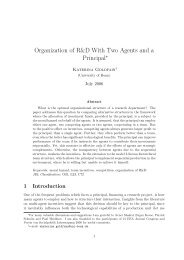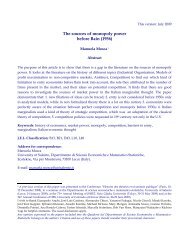Competition, Innovation, and Antitrust. A Theory of Market ... - Intertic
Competition, Innovation, and Antitrust. A Theory of Market ... - Intertic
Competition, Innovation, and Antitrust. A Theory of Market ... - Intertic
Create successful ePaper yourself
Turn your PDF publications into a flip-book with our unique Google optimized e-Paper software.
1.3 A Simple Model <strong>of</strong> <strong>Competition</strong> in Prices 23<br />
the quantity <strong>of</strong> production). However, price commitments can be reasonable<br />
in the short run (for instance in seasonal markets), or when there are small<br />
menu costs <strong>of</strong> changing prices or it is costly to acquire the information needed<br />
to reoptimize on the price choice. In the next chapter we will deal with the<br />
commitment problem in a deeper way <strong>and</strong> we will suggest that there are<br />
realistic ways in which a strategic investment can be a good substitute for a<br />
commitment to a strategy. For now we will assume that a firm can simply<br />
commit to a pricing strategy <strong>and</strong> analyze the consequence <strong>of</strong> this.<br />
Concerning the Stackelberg equilibrium we do not have analytical solutions.<br />
However, it is important to underst<strong>and</strong> the nature <strong>of</strong> the incentives<br />
<strong>of</strong> the firms, which is now rather different from the model with competition<br />
in quantities. Here the leader is aware that an increase in its own price will<br />
lead the followers to increase their prices, which exerts a positive effect on<br />
the pr<strong>of</strong>its <strong>of</strong> the leader. Accordingly, the commitment possibility is generally<br />
used adopting an accommodating strategy: the leader chooses a high price to<br />
induce its followers to choose high prices as well. 23 The only case in which<br />
this does not happen is when the fixed costs <strong>of</strong> production are high enough<br />
<strong>and</strong> the leader finds it better to deter entry. This can only be done adopting a<br />
low enough price: therefore the leader can be aggressive only for exclusionary<br />
purposes.<br />
This st<strong>and</strong>ard result emphasizes a possible inconsistency within the model<br />
<strong>of</strong> price leadership, at least when applied to describe real markets. We have<br />
suggested that leaders are accommodating when the fixed costs <strong>of</strong> production<br />
(or entry) are small, because in such a case an exclusionary strategy would<br />
require to set a very low price <strong>and</strong> would be too costly. But these are exactly<br />
the conditions under which other firms may want to enter in the market: fixed<br />
costs are low <strong>and</strong> exclusionary strategies by incumbents are costly. Therefore,<br />
the assumption that the number <strong>of</strong> firms (<strong>and</strong> in particular <strong>of</strong> the number <strong>of</strong><br />
followers) is fixed becomes quite unrealistic.<br />
Let us look at the Stackelberg equilibrium with endogenous entry. The<br />
solution in this case is slightly more complex, but it can be fully characterized.<br />
First <strong>of</strong> all, as usual, let us look at the stage in which the leader has already<br />
chosen its price p L <strong>and</strong> the followers enter <strong>and</strong> choose their prices. As before,<br />
their choice will follow the rule:<br />
1<br />
p i = c +<br />
λ(1 − D i /N )<br />
where the dem<strong>and</strong> on the right h<strong>and</strong> side depends on the price <strong>of</strong> the leader<br />
<strong>and</strong> all the other prices as well. However, under free entry we must have also<br />
that the markup <strong>of</strong> the followers exactly covers the fixed cost <strong>of</strong> production:<br />
D i (p i − c) =F<br />
23 Nevertheless, the followers will have incentives to choose a lower price than the<br />
leader, <strong>and</strong> each one <strong>of</strong> them will then have a larger dem<strong>and</strong> <strong>and</strong> pr<strong>of</strong>its than the<br />
leader: there is a second-mover advantage rather than a first-mover advantage.


